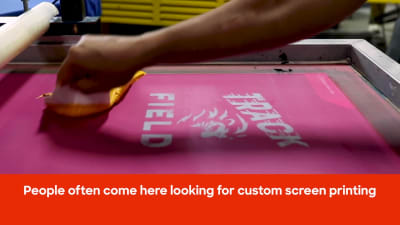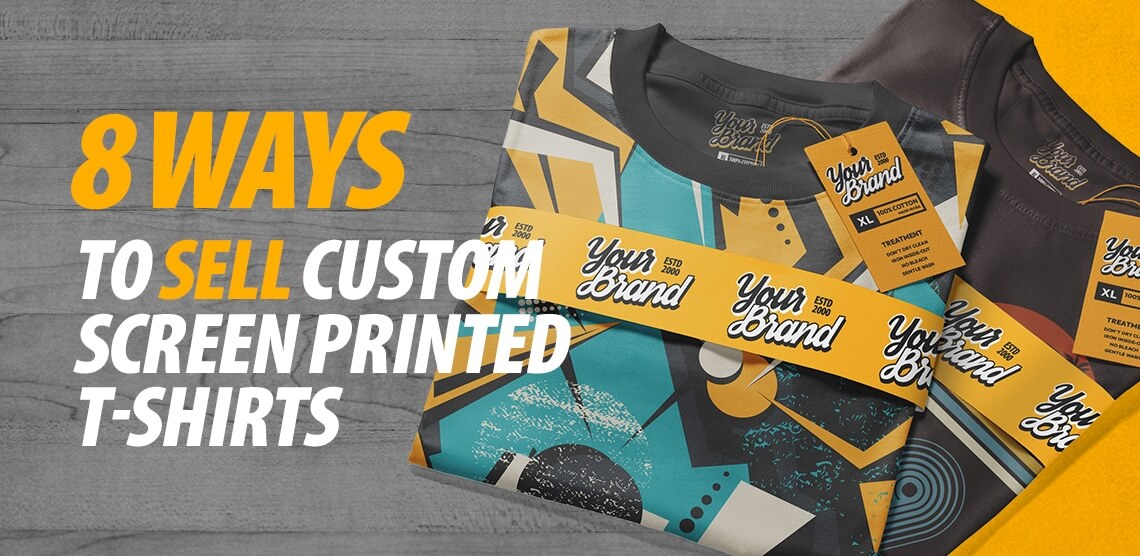Budget-Friendly T-Shirt Printing for Startups
Wiki Article
Screen Printing Uncovered: Every Little Thing You Need to Know Concerning T-Shirt and Garment Printing Techniques
Display printing is a remarkable approach that incorporates art with method, providing unlimited possibilities for creativity. All set to discover the crucial components that make display printing an art kind?
The Essentials of Display Printing: Exactly How It Works
When you dive into screen printing, you'll discover it's both a scientific research and an art. At its core, screen printing involves developing a pattern, or screen, that permits ink to pass with only in specific locations (screen printing kit). You start by picking your layout and preparing your display with a light-sensitive emulsion. Once you subject this solution to light, it solidifies, leaving your layout as a negative space.Position the display over the textile, after that use a squeegee to press ink via the screen onto the garment. Each step is necessary, and mastering them will raise your display printing abilities, transforming basic garments right into distinct, meaningful items.
Kinds Of Display Printing Methods
When you realize the basics of display printing, it's time to explore the numerous methods that can elevate your layouts. One preferred technique is conventional display printing, where ink is pressed via a stenciled screen. This technique is great for strong, lively shades. After that there's water-based ink printing, which provides a softer feel and is environmentally friendly, however it needs a different technique to treating.Another alternative is plastisol printing, recognized for its longevity and dazzling shades, making it a preferred for many brands. Experiment with halftone printing to develop slope effects and detailed designs.
Vital Devices for Display Printing
To attain magnificent results in screen printing, having the ideal tools is fundamental. You'll require a strong display printing frame, which holds the mesh that transfers your style onto the garment. Next off, invest in premium squeegees; these are essential for using ink evenly across the screen.Picking the Right Inks and Materials
When choosing inks and materials for display printing, you require to think about the sort of ink that works best for your job. Think of material compatibility to assure your styles look last and excellent long. Likewise, explore environment-friendly ink alternatives to make your printing procedure more sustainable.Types of Display Inks
Picking the ideal display ink is crucial for attaining dynamic, sturdy prints that fulfill your project's needs. There are a number of types of display inks to check out. Specialized inks, such as glow-in-the-dark or metal, can include unique results to your styles.
Fabric Compatibility Factors To Consider
Comprehending fabric compatibility is important for accomplishing high-quality display prints, specifically since various materials react distinctively to different inks. Always evaluate your inks on example textile to assure they stick correctly and preserve shade stability. Additionally, maintain in mind that material weight and structure can impact the last result, so choosing the ideal ink and material combo is essential for your task's success.Eco-Friendly Ink Options
Green inks are coming to be a popular selection for screen printers that wish to minimize their ecological influence while maintaining quality. When choosing inks, think about water-based inks, which are less harmful and much easier to cleanse up compared to typical solvents. These inks bond well with textiles, delivering dynamic outcomes without harmful chemicals. You could also discover eco-solvent inks that use less unstable natural substances (VOCs), making them a safer option for both your health and wellness and the world.Furthermore, seek inks made from renewable energies, such as soy or vegetable-based choices. By selecting the appropriate inks and materials, you'll not just produce magnificent designs yet additionally add to a much more sustainable printing process. Make the button, and your prints will certainly reflect your commitment to the setting!
Preparing Your Design for Display Printing

Submit Format Demands
To assure your layout looks vivid and sharp on material, you'll require to pay close focus to file style requirements for screen printing. Begin with vector files like AI or EPS, as they can be scaled without shedding high quality. If you utilize raster images, select high-resolution data, such as TIFF or PNG, preferably at 300 DPI. Prevent using JPEGs, as they can shed clearness when resized. Make sure your layout has a transparent history to prevent unwanted white sides on your prints. Maintain color modes in mind; CMYK is conventional for screen printing, so transform your RGB creates as necessary - screen printing kit. By complying with these standards, you'll set your art work up for a successful print.Color Separation Methods
Shade separation is a vital step in preparing your design for display printing, and understanding it can considerably boost your print quality. You'll require to damage your layout right into private shades, as each shade requires a different screen throughout printing. Beginning by recognizing all the shades in your layout and develop layers for each one. You can use software program like Adobe Photoshop or Illustrator to isolate and separate colors efficiently. Be certain to save each layer as a different data, generally in a layout like TIFF or PSD. visite site This accuracy not only guarantees precise color depiction yet also simplifies the printing procedure. By paying attention to shade separation, you'll achieve vivid and expert cause your screen-printed garments.Resolution and Dimension
Achieving the finest results in screen printing begins with guaranteeing your layout has the right resolution and size. Preferably, your artwork ought to go to the very least 300 DPI (dots per inch) for sharp, clear prints. If you use lower resolution, your last product might look pixelated and amateur.When it comes to size, consider the measurements of your print area. Layout your artwork to match the final print size, ideally creating it in the actual measurements you'll be publishing. This means, you'll avoid any type of unforeseen scaling problems.
Always inspect your style in both vector and raster styles. Vector graphics can be scaled without shedding top quality, making them perfect for screen printing. Preparing appropriately will ensure your layout looks impressive on every garment!
Step-by-Step Screen Printing Process
Screen printing is a dynamic process that allows you to produce lively designs on various surface areas. To my website get started, you'll require a screen, emulsion, and your picked ink.After rinsing the unexposed solution, your screen prepares. Establish it up on your printing surface area and straighten your garment beneath it. Pour ink onto the display and make use of a squeegee to press the ink with the stencil onto the material. Raise the screen very carefully and let the print dry. Treat the ink making use of warm to assure longevity. That's it! You have actually efficiently screen published your layout.
Tips for Successful Display Printing Projects
While you're diving into your display printing tasks, bear in mind that preparation is key to success. Beginning by collecting all your materials-- inks, squeegees, garments, and screens. A clean work area aids stop undesirable errors, so clean up before you start.Next, confirm your artwork is high-resolution and effectively sized for your garment. Check your display for appropriate direct exposure and clean it extensively to stay clear of smudges. When mixing your inks, adhere to the producer's guidelines to accomplish the best uniformity.
During printing, use also pressure with your squeegee for constant outcomes. Don't rush; take your time to validate each print fulfills your standards. After printing, allow your garments completely dry entirely before handling or packaging them.
Last but not least, constantly maintain a sample of your help future referral. This means, you can examine your progression and enhance your strategies over time. Delighted printing!

Frequently Asked Questions
How Long Does It Take to Set up a Display Printing Work?
Establishing a display printing task commonly takes around thirty minutes to an hour. You'll prepare the displays, mix inks, and change the press. The time varies based on complexity and experience, so remain arranged!Can I Publish on Different Material Types Utilizing the Exact Same Technique?
Yes, you can publish on different textile types making use of the same method, however you'll require to readjust your inks and setups. Some fabrics take in ink differently, so experimenting assurances the very best outcomes for every material.What Prevail Blunders to Prevent in Screen Printing?
When display printing, prevent common blunders like utilizing the wrong ink, neglecting correct exposure times, or skipping pre-press checks. Constantly evaluate your arrangement and keep tidy screens to assure top quality outcomes each time.How Can I Properly Tidy and Maintain My Display Printing Devices?
To correctly tidy and preserve your display printing devices, you should on a regular basis wash displays with suitable solvents, examine squeegees for wear, and guarantee all devices are stored dust-free and dry. Consistency enhances and avoids pricey repairs efficiency.Is Display Printing Environmentally Pleasant Contrasted to Other Approaches?
Screen printing can be a lot more eco-friendly than various other approaches, especially if you utilize water-based inks and eco-conscious products. By choosing sustainable products and practices, you decrease waste and lessen your influence on the planet.Screen Printing Uncovered: Whatever You Required to Know About T-Shirt and Garment Printing Methods
At its core, display printing involves producing a pattern, or display, that enables ink to pass via only in certain locations. Position the screen over check that the textile, then utilize a squeegee to push ink via the display onto the garment. One popular approach is standard screen printing, where ink is pressed with a stenciled display.When choosing inks and products for screen printing, you need to take into account the type of ink that functions best for your project.
Report this wiki page